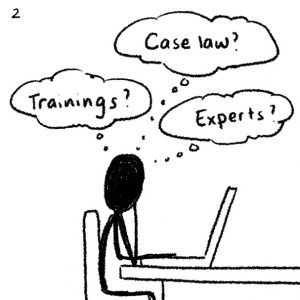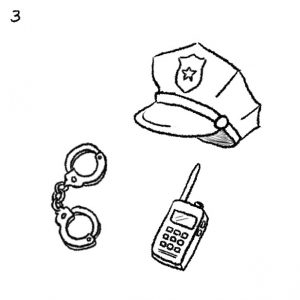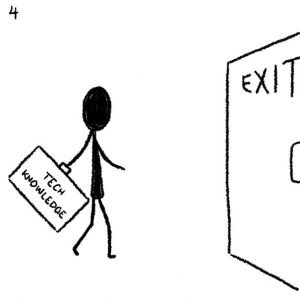Information Sharing
Public defenders lack good mechanisms to share information and collaborate across offices. In this section, we outline opportunities and constraints for technologists interested in building social computing tools for public defenders.
Public defenders (PDs) frequently describe lacking knowledge and the ability to share knowledge with other public defenders. A better network for information sharing between public defenders would be useful in three areas: as a place to share case law examples and resources about new forms of technical and scientific evidence, a place to find and vet experts, and a place to organize around structural problems.
The heterogeneous structure of public defense offices and lack of good internal IT, combined with nondisclosure requirements that prevent public defenders from sharing identifying information about their clients, makes constructing such a system challenging. However, having a centralized platform to securely facilitate public defender communication would help the community share resources and keep big-picture reforms in mind.
Oftentimes I’ll ask the state court lawyers for the discovery that they got and they will have gotten [something] different, or there are records that they got that I didn’t get. Communication definitely happens, but that’s more on a person … micro level, rather than … let’s all band together and present a united front.
– Federal Public Defender
Storyboard
Explore this depiction of a public defender’s experiences navigating, and attempting to access information about, unfamiliar technology.



1. A new public defender has a case involving law enforcement’s use of ShotSpotter, a forensic technological tool that the public defender is unfamiliar with.
2. The public defender looks for resources on ShotSpotter. They look for experts in ShotSpotter technology, as well as trainings and relevant case law.
3. As the public defender learns more about ShotSpotter, they have a hunch that law enforcement may have abused ShotSpotter in their area. They’re interested in knowing more about how law enforcement uses ShotSpotter in their cases.

4. In due time, this public defender becomes very knowledgeable in ShotSpotter as a tool and becomes the go-to person for this technology in their office. Then, however, they leave the office for another position.
Issues & Needs
See the issues and needs associated with each step of the process.
STEP
ISSUES
NEEDS

1. New case with unfamiliar technology
Tech-Knowledge(y) Disparity
- With prosecutors and law enforcement becoming increasingly equipped with emerging technologies and their operation, public defenders are often left playing catch-up
- Greater transparency around new technologies in use by prosecutors and law enforcement
[In a DUI Homicide we got these car black boxes] We’re scrambling to figure out, how the heck do we even read these?
– Felony Public Defender

2. In search of learning resources about the technology
Knowledge Building
- It can be difficult for public defenders to access reliable information about an unfamiliar technology, including how it works, the legality of its use, the case law that applies to it, and if any public defenders in their network have dealt with it
- Central, accessible, updatable location for reliable information about unfamiliar technologies, including how they work and the legal contexts in which they’ve been used before
I don’t really understand how torrenting works, you know, like, and I don’t really feel qualified explaining that to a judge
– Bay Area Misdemeanor Public Defender

3. Investigating potential structural issues impacting their cases
Structural Entanglement
- When public defenders suspect structural biases at play, it can be difficult to coordinate an investigation within a public defense office or between offices
- Challenges (due to time availability and work styles) getting public defenders and public defense staff to consistently collect data to inform investigations into structural bias. For example, some public defenders may be more or less inclined to consistently enter data into spreadsheets than others
- Method to securely share information between and within public defense offices (with appropriate legal redactions)
- Mechanisms to accommodate and promote data collection among diverse types of users within public defense offices

4. Knowledgeable public defender leaves for another office
Lack of Offboarding
- Public defenders often develop expertise with a particular technology and, within an office, become the “go-to” person for advice on that technology
- When that person leaves an office, their knowledge leaves with them
- Mechanisms to support and promote the trusted transfer and sharing of knowledge within a public defense office and network
Solutions
Below, we provide a few potential approaches to addressing public defenders’ challenges working with information sharing. We encourage you to consider these approaches as well as your own.
- A platform for sharing information, such as redacted briefs and case law examples, that is usable and secure for public defenders
- A platform for sharing information within jurisdictions to report concerns and instances of abuse (by law enforcement or other parties and systems)
- A secure network to exchange knowledge on emerging technologies and the laws that govern them
- Collaborative workshops with technical experts in diverse fields of emerging technologies to foster engagement between public defenders and experts
- An authenticated repository to access shared, relevant training resources
We’ve been like collecting data ourselves. Each attorney will be told, “Hey, we are seeing that clients with X and Y charges, who are black, are being denied bail really often. Could you keep a spreadsheet of like these cases?” And then individual attorneys will keep spreadsheets, and we’ll send these spreadsheets into like one person to consolidate [it]. I just wonder if there is a more efficient way to do that
– Bay Area Public Defender
Constraints
General Constraints
Social Computing Specific Constraints
Lack of resources: Public defense offices have limited budgets and staff to acquire and maintain new technologies.
Privacy and security requirements: Privacy is critical. Not only are the costs to breaches of client privacy extremely high, but public defenders should only have access to surveillance data and case information used in their own cases.
Heterogeneous IT environments: The basic technical environment differs widely between public defense offices in different jurisdictions and in different regions. Most of the Bay Area public defenders we spoke with had laptops, phones, wifi, and VPNS. In other areas, public defenders relied on landlines and aging desktops, and were forced to use their personal data plans for communicating with clients and downloading data.
How to keep prosecutors out: The judicial system is adversarial, and public defenders are wary of technologies, particularly evidence processing or central repositories of information which may be accessed by prosecutors.
Confidentiality and conflict of interests: It is illegal for defense council to share information about a case or client with anyone not working on the case.
Maintaining accuracy: Outdated or inaccurate technical information may be worse than no information. Designers must think carefully about how to maintain quality in user-sourced content.
Avoiding manipulation through dark-pattern designs: Any information exchanged between defenders should be presented in fair and neutral ways to avoid traditional dark patterns (e.g., misdirection, trick questioning, confirmshaming or “roach motel” user experience flows) that may manipulate decision-making behaviors when interacting on digital networks.
Policy Implications
Big Picture Reforms
- Reduce caseloads by diverting cases away from the criminal justice system and increasing public defense budgets.
Reforms to Improve Transparency in Surveillance Data Acquisition
- Advocate for ordinances to provide transparency and regulation around local acquisition of surveillance data systems. [1][2][3] Two important models are Oakland’s PAC Surveillance Technology Ordinance, which requires disclosure of new technologies and prohibits not disclosure agreements, and Seattle’s 2013 ordinance, which requires city council approval for acquisition of new technologies.
- Extend such ordinances to include disclosure rules for surveillance in jails, prisons, and public housing [4, 5]
- Include explicit requirements for public defender engagement in the acquisition of surveillance data systems [6]
- Consider exceptions to trade secrets and copyright laws to require that defense council have access to information about technologies used to process evidence used in criminal courts [3][5]
Specific Reforms to improve Public Defenders’ Ability to Share Information
- Requirements for record-keeping in public defense offices [7]
The DNA testing is done by the … medical examiner’s office, you know, which is supposedly an unbiased entity … the information I’m not going to get access to that I would want is the actual software that they use to analyze [the] DNA… that’s stuff that is trade secrets that the company will allow us to look at
– Bay Area Public Defender
- Mulligan, D. K., & Bamberger, K. A. (2018). Saving Governance-By-Design. California Law Review, 106(3). https://doi.org/10.15779/Z38QN5ZB5H
- Greene, D., & Patterson, G. (2018). Can we trust computer with body-cam video? Police departments are being led to believe AI will help, but they should be wary. IEEE Spectrum, 55(12), 36–48. https://doi.org/10.1109/MSPEC.2018.8544982
- Owens, K., Cobb, C., & Cranor, L. F. (2021). “You Gotta Watch What You Say’’: Surveillance of Communication with Incarcerated People. 18.
- Joh, E. E. (2017). The Undue Influence of Surveillance Technology Companies on Policing. New University Law Review, 92. https://doi.org/10.2139/ssrn.2924620
- Wexler, R. (2017). Life, Liberty, and Trade Secrets: Intellectual Property in the Criminal Justice System. Stanford Law Review, 70. https://doi.org/10.2139/ssrn.2920883
- Wexler, R. (2019). Privacy Asymmetries: Access to Data in Criminal Investigations (SSRN Scholarly Paper ID 3428607). Social Science Research Network. https://doi.org/10.2139/ssrn.3428607
- Metzger, P., & Ferguson, A. G. (2015). Defending Data. SOUTHERN CALIFORNIA LAW REVIEW, 88(1057), 69.

